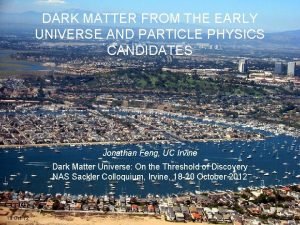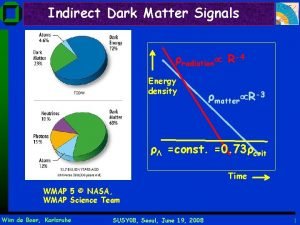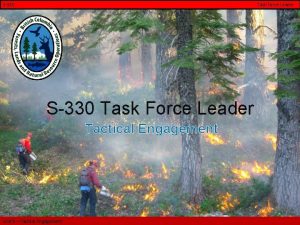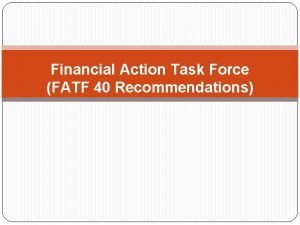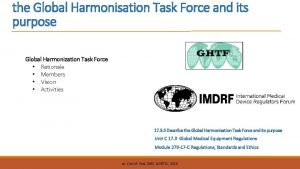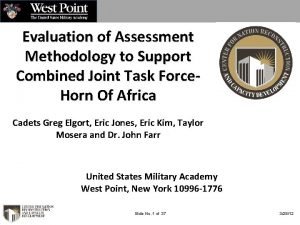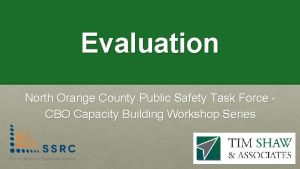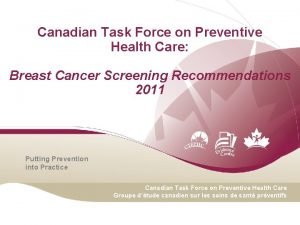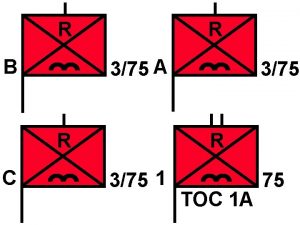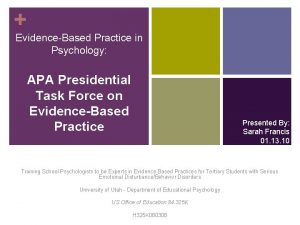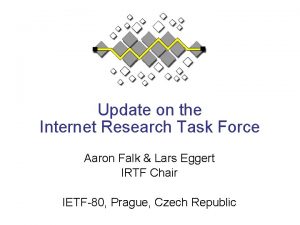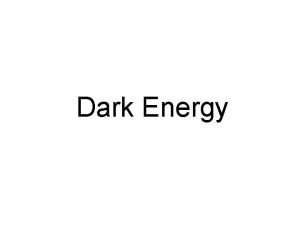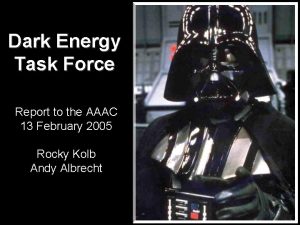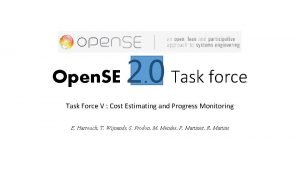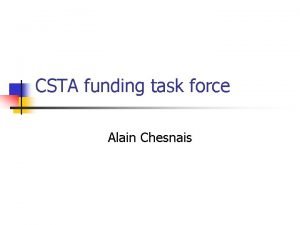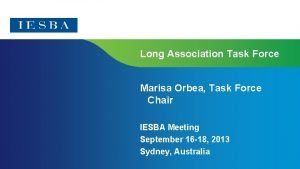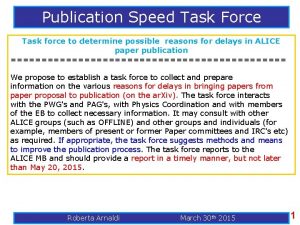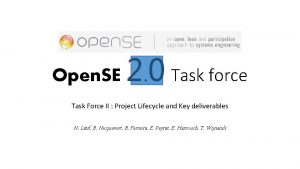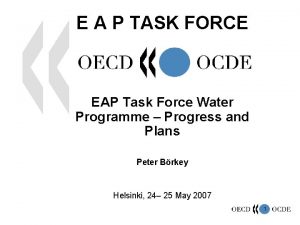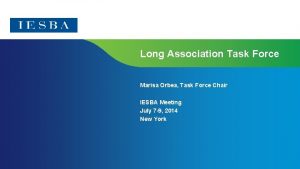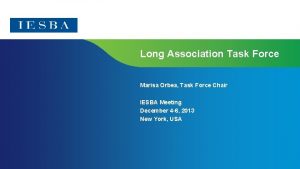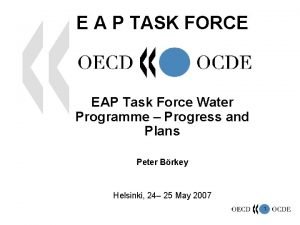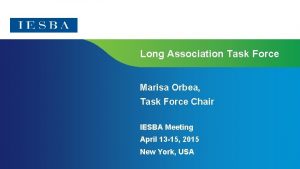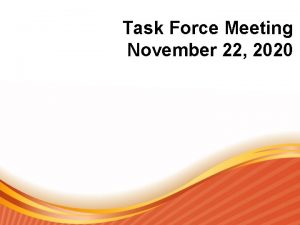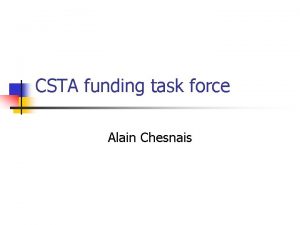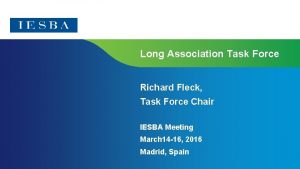Report of the Dark Energy Task Force Report










































- Slides: 42

Report of the Dark Energy Task Force Report to AAAC 12 May 2006 Rocky Kolb

Dark Energy Dark energy appears to be the dominant component of the physical Universe, yet there is no persuasive theoretical explanation. The acceleration of the Universe is, along with dark matter, the observed phenomenon which most directly demonstrates that our fundamental theories of particles and gravity are either incorrect or incomplete. Most experts believe that nothing short of a revolution in our understanding of fundamental physics will be required to achieve a full understanding of the cosmic acceleration. For these reasons, the nature of dark energy ranks among the very most compelling of all outstanding problems in physical science. These circumstances demand an ambitious observational program to determine the dark energy properties as well as possible.

Dark Energy Task Force (DETF) http: //www. nsf. gov/mps/ast/detf. jsp • Three agencies: DOE; NASA; NSF • Two subcommittees: AAAC (Illingworth); HEPAP (Shochet) • Two charge letters: Kinney (NASA); Staffin (DOE); Turner (NSF) • Thirteen members: Overlap with AAAC, HEPAP, SDT

DETF Membership • Members Andy Albrecht, Davis Gary Bernstein, Penn Bob Cahn, LBNL Wendy Freedman, OCIW Jackie Hewitt, MIT Wayne Hu, Chicago John Huth, Harvard Mark Kamionkowski, Caltech Rocky Kolb, Fermilab/Chicago Lloyd Knox, Davis John Mather, GSFC Suzanne Staggs, Princeton Nick Suntzeff, NOAO • Agency Representatives – DOE: Kathy Turner – NASA: Michael Salamon Ron Hellings – NSF: Dana Lehr

Dark Energy Task Force Charge* “The DETF is asked to advise the agencies on the optimum† near and intermediate-term programs to investigate dark energy and, in cooperation with agency efforts, to advance the justification, specification and optimization of LST# and JDEM‡. ” 1. Summarize existing program of funded projects 2. Summarize proposed and emergent approaches 3. Identify important steps, precursors, R&D, … 4. Identify areas of dark energy parameter space existing or proposed projects fail to address 5. Prioritize approaches (not projects) * Fair range of interpretations of charge. Optimum minimum (agencies); Optimum maximal (community) # LST Large Survey Telescope ‡ JDEM Joint Dark Energy Mission †

Dark Energy Task Force (DETF) http: //www. nsf. gov/mps/ast/detf. jsp • Draft Report submitted to AAAC and HEPAP 7 May 2006 (5 months late!) • Preliminary Report reviewed by six readers suggested by AAAC & HEPAP who made very helpful comments. The DETF responded to each comment and improved the report in the process • Preliminary Reports AAAC (Feb 13 2006) HEPAP (Mar 4) P 5 (April 21) • Weekly phonecons plus five face-to-face meetings • 50 Whitepapers from community

Dark Energy Task Force Report Context The issue: acceleration of the Universe Possibilities: dark energy (L or not), non-GR Motivation for future investigations Goals and Methodology Goal of dark energy investigations Methodology to analyze techniques/implementations Findings Techniques & implementations (largely from White Papers) Systematic uncertainties What we learned from analysis Recommendations A Dark Energy Primer DETF Fiducial Model and Figure of Merit Staging Stage IV from the Ground and/or Space DETF Technique Performance Projections Dark Energy Projects (Present and Future) Technical Appendix

Context 1. Conclusive evidence for acceleration of the Universe. Standard cosmological framework dark energy (70% of mass-energy). 2. Possibility: Dark Energy constant in space & time (Einstein’s L). 3. Possibility: Dark Energy varies with time (or redshift z or a = (1+z)-1). 4. Impact of dark energy can be expressed in terms of “equation of state” w(a) = p(a) / r(a) with w(a) = -1 for L. 5. Possibility: GR or standard cosmological model incorrect. 6. Not presently possible to determine the nature of dark energy.

Context 7. Dark energy appears to be the dominant component of the physical Universe, yet there is no persuasive theoretical explanation. The acceleration of the Universe is, along with dark matter, the observed phenomenon which most directly demonstrates that our fundamental theories of particles and gravity are either incorrect or incomplete. Most experts believe that nothing short of a revolution in our understanding of fundamental physics will be required to achieve a full understanding of the cosmic acceleration. For these reasons, the nature of dark energy ranks among the very most compelling of all outstanding problems in physical science. These circumstances demand an ambitious observational program to determine the dark energy properties as well as possible.

Goals and Methodology 1. The goal of dark-energy science is to determine the very nature of the dark energy that causes the Universe to accelerate and seems to comprise most of the mass-energy of the Universe. 2. Toward this goal, our observational program must: a. Determine whether the accelerated expansion is due to a cosmological constant. b. If it is not due to a constant, probe the underlying dynamics by measuring as well as possible the time evolution of dark energy, for example by measuring w(a); our parameterization w(a) = w 0 + wa(1 - a). c. Search for a possible failure of GR through comparison of cosmic expansion with growth of structure. 3. Goals of dark-energy observational program through measurement of expansion history of Universe [d. L(z) , d. A(z) , V(z)], and through measurement of growth rate of structure. All described by w(a). If failure of GR, possible difference in w(a) inferred from different types of data.

(From the Foreword) Because the field is so new, it has suffered from a lack of standardization which has made it very difficult to directly compare different approaches. To address this problem we have done our own modeling of the different techniques so that they could be compared in a consistent manner. These quantitative calculations form the basis of our extensive factual findings, on which our recommendations are based

Goals and Methodology 4. To quantify progress in measuring properties of dark energy we define dark energy figure-of-merit from combination of uncertainties in w 0 and wa. The DETF figure-of-merit is the reciprocal of the area of the error ellipse enclosing the 95% confidence limit in the w 0–wa plane. Larger figure-of-merit indicates greater accuracy. 5. Figure of merit serves as a quantitative guide to constrain a large, but not exhaustive, set of dark-energy models. The nature of dark energy is poorly understood; no single figure of merit is appropriate for every eventuality. Potential shortcomings of the choice of any figure of merit must be evaluated in the larger context, which includes the critical need to make side-by-side comparisons. In our judgment there is no better choice of a figure of merit available at this time. 6. We made extensive use of statistical (Fisher-matrix) techniques incorporating CMB and H 0 information to predict future performance (75 models).

Goals and Methodology 7. Our considerations follow developments in Stages: I. What is known now (12/31/05). II. Anticipated state upon completion of ongoing projects. III. Near-term, medium-cost, currently proposed projects. IV. Large-Survey Telescope (LST) and/or Square Kilometer Array (SKA), and/or Joint Dark Energy (Space) Mission (JDEM). 8. Dark-energy science has far-reaching implications for other fields of physics discoveries in other fields may point the way to understanding nature of dark energy (e. g. , evidence for modification of GR).

Nineteen Findings 1. Four observational techniques dominate White Papers: a. Baryon Acoustic Oscillations (BAO) large-scale surveys measure features in distribution of galaxies. BAO: d. A(z) and H(z). b. Cluster (CL) surveys measure spatial distribution of galaxy clusters. CL: d. A(z), H(z), growth of structure. c. Supernovae (SN) surveys measure flux and redshift of Type Ia SNe. SN: d. L(z). d. Weak Lensing (WL) surveys measure distortion of background images due to gravitational lensing. WL: d. A(z), growth of structure. 2. Different techniques have different strengths and weaknesses and sensitive in different ways to dark energy and other cosmo. parameters. 3. Each of the four techniques can be pursued by multiple observational approaches (radio, visible, NIR, x-ray observations), and a single experiment can study dark energy with multiple techniques. Not all missions necessarily cover all techniques; in principle different combinations of projects can accomplish the same overall goals.

Nineteen Findings 4. Four techniques at different levels of maturity: a. BAO only recently established. Less affected by astrophysical uncertainties than other techniques. b. CL least developed. Eventual accuracy very difficult to predict. Application to the study of dark energy would have to be built upon a strong case that systematics due to non-linear astrophysical processes are under control. c. SN presently most powerful and best proven technique. If photo-z’s are used, the power of the supernova technique depends critically on accuracy achieved for photo-z’s. If spectroscopically measured redshifts are used, the power as reflected in the figure-of-merit is much better known, with the outcome depending on the ultimate systematic uncertainties. d. WL also emerging technique. Eventual accuracy will be limited by systematic errors that are difficult to predict. If the systematic errors are at or below the level proposed by the proponents, it is likely to be the most powerful individual technique and also the most powerful component in a multi-technique program.

Systematics: none, optimistic, pessimistic

Nineteen Findings 5. A program that includes multiple techniques at Stage IV can provide more than an order-of-magnitude increase in our figure-of-merit. This would be a major advance in our understanding of dark energy. 6. No single technique is sufficiently powerful and well established that it is guaranteed to address the order-of-magnitude increase in our figure-ofmerit alone. Combinations of the principal techniques have substantially more statistical power, much more ability to discriminate among dark energy models, and more robustness to systematic errors than any single technique. Also, the case for multiple techniques is supported by the critical need for confirmation of results from any single method.


Nineteen Findings 7. Results on structure growth, obtainable from weak lensing or cluster observations, are essential program components in order to check for a possible failure of general relativity. 8. In our modeling we assume constraints on H 0 from current data and constraints on other cosmological parameters expected to come from measurement of CMB temperature and polarization anisotropies. a. These data, though insensitive to w(a) on their own, contribute to our knowledge of w(a) when combined with any of the dark energy techniques we have considered. b. Increased precision in a particular cosmological parameter may improve dark energy constraints from a single technique, valuable for comparing independent methods. 9. Improvements in cosmological parameters tend not to improve knowledge of dark energy from a multi-technique program 10. Setting spatial curvature to zero greatly helps SN, but modest impact on other techniques. Little difference when in combination.

Nineteen Findings s (H 0): 8 km s -1 Mpc-1 4 km s-1 Mpc-1 k = 0 prior

Nineteen Findings 11. Optical, IR, and X-ray experiments with very large numbers of astronomical targets will rely on photometrically determined redshifts. The ultimate accuracy that can be attained for photo-z's is likely to determine the power of such measurements. Traditional redshift from spectroscopy Photometric redshift from multicolor photometry

Nineteen Findings 12. Our inability to forecast reliably systematic error levels is the biggest impediment to judging the future capabilities of the techniques. We need a. b. c. d. BAO– Theoretical investigations of how far into the non-linear regime the data can be modeled with sufficient reliability and further understanding of galaxy bias on the galaxy power spectrum. CL– Combined lensing and Sunyaev-Zeldovich and/or X-ray observations of large numbers of galaxy clusters to constrain the relationship between galaxy cluster mass and observables. SN– Detailed spectroscopic and photometric observations of about 500 nearby supernovae to study the variety of peak explosion magnitudes and any associated observational signatures of effects of evolution, metallicity, or reddening, as well as improvements in the system of photometric calibrations. WL– Spectroscopic observations and multi-band imaging of tens to hundreds of thousands of galaxies out to high redshifts and faint magnitudes in order to calibrate the photometric redshift technique and understand its limitations. It is also necessary to establish how well corrections can be made for the intrinsic shapes and alignments of galaxies, removal of the effects of optics (and from the ground) the atmosphere and to characterize the anisotropies in the point-spread function.

Nineteen Findings 13. Six types of Stage III projects have been considered: a. a BAO survey on an 8 -m class telescope using spectroscopy b. a BAO survey on an 4 -m class telescope using photo-z’s c. a CL survey on an 4 -m class telescope using photo-z’s for clusters detected in ground-based SZ surveys d. a SN survey on a 4 -m class telescope using spectroscopy from a 8 -m class telescope e. a SN survey on a 4 -m class telescope using photo-z’s f. A WL survey on a 4 -m class telescope using photo-z’s a. These projects are typically projected by proponents to cost in the range of 10 s of $M.

Nineteen Findings 14. Our findings regarding Stage-III projects are 1. Only an incremental increase in knowledge of dark-energy parameters is likely to result from a Stage-III BAO project using photo-z’s. The primary benefit would be in exploring photo-z uncertainties. 2. A modest increase in knowledge of dark-energy parameters is likely to result from Stage-III SN project using photo-z’s. Such a survey would be valuable if it were to establish the viability of photometric determination of supernova redshifts, types, and evolutionary effects. 3. A modest increase in knowledge of dark-energy parameters is likely to result from any single Stage-III CL, WL, spectroscopic BAO, or spectroscopic SN survey. 4. The SN, CL, or WL techniques could, individually, produce factor-oftwo improvements in the DETF figure-of-merit, if the systematic errors are close to what the proponents claim. 5. If executed in combination, Stage-III projects would increase the DETF figure-of-merit by a factor in the range of approximately three to five, with the large degree of uncertainty due to uncertain forecasts of systematic errors.

DETF Projections

Combination of all techniques from a Stage-III photometric survey Stage III-p Stage III-o

Nineteen Findings 15. Four types of next-generation (Stage IV) projects have been considered: a. an optical Large Survey Telescope (LST), using one or more of the four techniques b. an optical/NIR JDEM satellite, using one or more of four techniques c. an x-ray JDEM satellite, which would study dark energy by the cluster technique d. a Square Kilometer Array, which could probe dark energy by weak lensing and/or the BAO technique through a hemisphere-scale survey of 21 -cm emission Each of these projects is in the $0. 3 -1 B range, but dark energy is not the only (in some cases not even the primary) science that would be done by these projects. According to the White Papers received by the Task Force, the technical capabilities needed to execute LST and JDEM are largely in hand. The Task Force is not constituted to undertake a study of the technical issues. 16. Each of the Stage IV projects considered (LST, JDEM, and SKA) offers compelling potential for advancing our knowledge of dark energy as part of a multi-technique program.

Nineteen Findings 17. The Stage IV experiments have different risk profiles: a. SKA would likely have very low systematic errors, but needs technical advances to reduce its cost. The performance of SKA would depend on the number of galaxies it could detect, which is uncertain. b. Optical/NIR JDEM can mitigate systematics because it will likely obtain a wider spectrum of diagnostic data for SN, CL, and WL than possible from ground, incurring the usual risks of a space mission. c. LST would have higher systematic-error risk, but can in many respects match the statistical power of JDEM if systematic errors, especially those due to photo-z measurements, are small. An LST Stage IV program can be effective only if photo-z uncertainties on very large samples of galaxies can be made smaller than what has been achieved to date.

Nineteen Findings 18. A mix of techniques is essential for a fully effective Stage IV program. The technique mix may be comprised of elements of a ground-based program, or elements of a space-based program, or a combination of elements from ground- and space-based programs. No unique mix of techniques is optimal (aside from doing them all), but the absence of weak lensing would be the most damaging provided this technique proves as effective as projections suggest.

DETF Projections

Combination of all techniques from Stage-IV ground-based survey Stage II Stage IV-p Stage IV-o

DETF Projections

Combination of all techniques from Stage-IV space-based survey Stage II Stage IV-p Stage IV-o

DETF Projections

Nineteen Findings 19. The one-dimensional errors in w 0 and wa are correlated, and their product is not a good indication of the power of a particular experiment. This is why the DETF figure-of-merit is defined as the area contained within the 95% confidence limit contours in the w 0–wa plane (not the simple product of one-dimensional uncertainties in w 0 and wa). We discuss the DETF figure-of-merit. We also discuss the utility of defining a pivot value of w, defined as wp. The pivot value of w is the best constrained value by a particular experiment; it is also equal to the value of w assuming wa = 0. We demonstrate that the figure of merit is the inverse of the product of uncertainties in wp and wa.

Recommendations O. An immediate and dramatic increase in funding for all theoretical cosmology efforts in the Chicago area. (This course of action is so obvious it is not actually stated in the report)

Six Recommendations I. We strongly recommend that there be an aggressive program to explore dark energy as fully as possible, since it challenges our understanding of fundamental physical laws and the nature of the cosmos. II. We recommend that the dark energy program have multiple techniques at every stage, at least one of which is a probe sensitive to the growth of cosmological structure in the form of galaxies and clusters of galaxies. III. We recommend that the dark energy program include a combination of techniques from one or more Stage III projects designed to achieve, in combination, at least a factor of three gain over Stage II in the DETF figure-of-merit, based on critical appraisals of likely statistical and systematic uncertainties.

Six Recommendations IV. We recommend that the dark energy program include a combination of techniques from one or more Stage IV projects designed to achieve, in combination, at least a factor of ten gain over Stage II in the DETF figure-of-merit, based on critical appraisals of likely statistical and systematic uncertainties. Because JDEM, LST, and SKA all offer promising avenues to greatly improved understanding of dark energy, we recommend continued research and development investments to optimize the programs and to address remaining technical questions and systematic-error risks. V. We recommend that high priority for near-term funding should be given as well to projects that will improve our understanding of the dominant systematic effects in dark energy measurements and, wherever possible, reduce them, even if they do not immediately increase the DETF figure-of-merit.

Six Recommendations VI. We recommend that the community and the funding agencies develop a coherent program of experiments designed to meet the goals and criteria set out in these recommendations.

DETF Legacy I. Standardization 1. Parameterize dark energy as w 0 – wa 2. Eight-parameter cosmological model 3. Priors 4. Figure of merit II. Importance of combinations 1. Soon will have a website with library of Fisher matrices & combiner programs (All power to the people!) III. DETF Technique Performance Projections 1. Thirty-two (count ‘em, 32!) data models 2. Optimistic & pessimistic projections 3. Four techniques, two stages, five platforms IV. Use DETF Technique Performance Projections as a guideline!!! 1. We may be off-base (proposers must justify systematic-error budget!) 2. People get smarter

From the transmittal letter The report is a comprehensive study of the dark energy issue, perhaps the most compelling of all outstanding problems in physical science. In the Report, we outline the crucial need for a vigorous program to explore dark energy as fully as possible, since it challenges our understanding of fundamental physical laws and the nature of the cosmos. We recommend that program elements include 1. An immediate investment in projects that will improve our understanding of the dominant systematic effects in dark energy measurements and lead to their reduction. 2. An immediate start of a near-term program (which we call Stage III) designed to advance our knowledge of dark energy and prepare for the ultimate “Stage IV” program, which consists of a combination of large survey telescopes and/or a space mission. 3. Expanded support for design and development funds of proposed Stage IV projects. This will allow the relative benefits, risks, and costs of these projects to be much better known soon. 4. Rapid decisions on the appropriate Stage IV projects

DETF Membership • Members Andy Albrecht, Davis Gary Bernstein, Penn Bob Cahn, LBNL Wendy Freedman, OCIW Jackie Hewitt, MIT Wayne Hu, Chicago John Huth, Harvard Mark Kamionkowski, Caltech Rocky Kolb, Fermilab/Chicago Lloyd Knox, Davis John Mather, GSFC Suzanne Staggs, Princeton Nick Suntzeff, NOAO • Agency Representatives – DOE: Kathy Turner – NASA: Michael Salamon Ron Hellings – NSF: Dana Lehr
 Dark matter and dark energy ppt
Dark matter and dark energy ppt In the dark dark town
In the dark dark town Tiered task bias task
Tiered task bias task Energy energy transfer and general energy analysis
Energy energy transfer and general energy analysis Energy energy transfer and general energy analysis
Energy energy transfer and general energy analysis Cube of stabilized dark energy
Cube of stabilized dark energy Dma dark energy
Dma dark energy Nwcg s-330
Nwcg s-330 Enemy mechanized infantry section symbol
Enemy mechanized infantry section symbol Glencoe sustainability task force
Glencoe sustainability task force Samy tarazi
Samy tarazi Iowa food protection task force
Iowa food protection task force Fatf40
Fatf40 Green ribbon task force
Green ribbon task force Princeton policy task force
Princeton policy task force Desktop management task force
Desktop management task force Anchor institutions task force
Anchor institutions task force Global harmonization task force
Global harmonization task force Social performance task force
Social performance task force Marketing task force
Marketing task force Combined joint task force horn of africa
Combined joint task force horn of africa North orange county public safety task force
North orange county public safety task force Ctfphc
Ctfphc Army unit symbols
Army unit symbols Iowa food protection task force
Iowa food protection task force Apa presidential task force on evidence-based practice
Apa presidential task force on evidence-based practice Internet research task force
Internet research task force Social exclusion task force
Social exclusion task force Appell schreiben musterlösung
Appell schreiben musterlösung South florida ecosystem restoration task force
South florida ecosystem restoration task force Born with a mic flocabulary
Born with a mic flocabulary Hát kết hợp bộ gõ cơ thể
Hát kết hợp bộ gõ cơ thể Frameset trong html5
Frameset trong html5 Bổ thể
Bổ thể Tỉ lệ cơ thể trẻ em
Tỉ lệ cơ thể trẻ em Voi kéo gỗ như thế nào
Voi kéo gỗ như thế nào Chụp tư thế worms-breton
Chụp tư thế worms-breton Chúa yêu trần thế alleluia
Chúa yêu trần thế alleluia Các môn thể thao bắt đầu bằng tiếng đua
Các môn thể thao bắt đầu bằng tiếng đua Thế nào là hệ số cao nhất
Thế nào là hệ số cao nhất Các châu lục và đại dương trên thế giới
Các châu lục và đại dương trên thế giới Công thức tính thế năng
Công thức tính thế năng Trời xanh đây là của chúng ta thể thơ
Trời xanh đây là của chúng ta thể thơ





